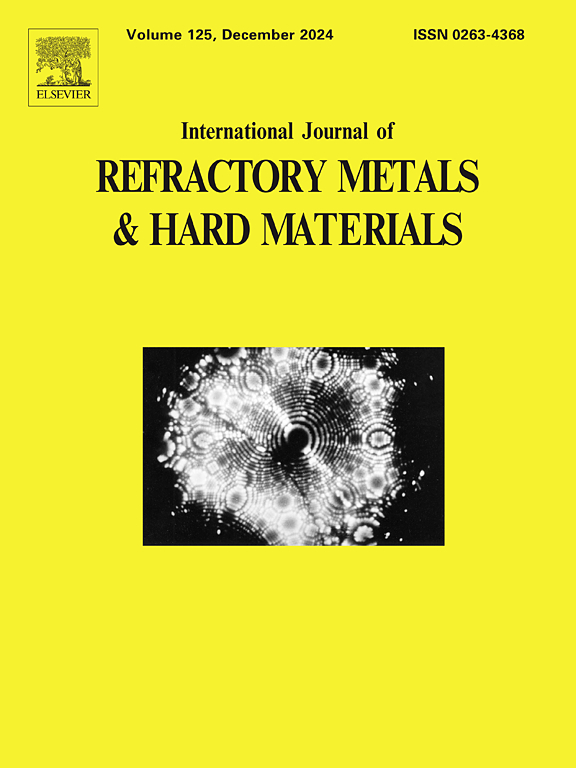Sintering-driven densification mechanisms and temperature-adaptive tribological behavior of cBN/CuSnTi composites fabricated via powder extrusion printing
IF 4.6
2区 材料科学
Q2 MATERIALS SCIENCE, MULTIDISCIPLINARY
International Journal of Refractory Metals & Hard Materials
Pub Date : 2025-07-18
DOI:10.1016/j.ijrmhm.2025.107336
引用次数: 0
Abstract
Cubic boron nitride (cBN)-reinforced metal matrix composites demonstrate exceptional mechanical performance as advanced tool materials. In this study, cBN/CuSnTi composites were fabricated via powder extrusion printing (PEP). The phase evolution, elemental partitioning, and interfacial architecture were systematically investigated. A comprehensive assessment of sintering-driven densification mechanisms, interfacial bonding mechanisms, and tribological behaviors was conducted. Results reveal a temperature-adaptive phase transformation sequence: Cu13.7Sn + Cu10Sn3 → Cu13.7Sn → Cu13.7Sn + Cu41Sn11 and semi-coherent cBN-reinforcement interfaces, achieving optimal flexural strength (719.1 MPa at 900 °C) and compressive strength (772.1 MPa at 1000 °C). The composite exhibits temperature-adaptive tribological performance. For the 800 °C sintered samples, the friction coefficient increased from 0.09 at room temperature to 0.27 at 300 °C. In contrast, the 900 °C sintered samples exhibited a decrease from 0.47 to 0.18 under the same temperature conditions.PEP-derived composites exhibit superior service-temperature programmability, with in situ oxide films improving high-temperature wear resistance.
粉末挤压印刷制备cBN/CuSnTi复合材料烧结驱动致密化机制及温度自适应摩擦学行为
立方氮化硼(cBN)增强金属基复合材料作为先进的刀具材料具有优异的机械性能。本研究采用粉末挤压印刷法制备了cBN/CuSnTi复合材料。系统地研究了相演化、元素划分和界面结构。对烧结驱动致密化机制、界面键合机制和摩擦学行为进行了综合评估。结果表明,Cu13.7Sn + Cu10Sn3→Cu13.7Sn→Cu13.7Sn + Cu41Sn11和半相干cbn -增强界面具有温度自适应的相变顺序,获得了最佳的抗折强度(900℃时为719.1 MPa)和抗压强度(1000℃时为772.1 MPa)。该复合材料具有温度自适应摩擦学性能。800℃烧结试样的摩擦系数从室温时的0.09增加到300℃时的0.27。相比之下,900°C烧结样品在相同温度条件下从0.47下降到0.18。pep衍生的复合材料具有优越的使用温度可编程性,其原位氧化膜提高了高温耐磨性。
本文章由计算机程序翻译,如有差异,请以英文原文为准。
求助全文
约1分钟内获得全文
求助全文
来源期刊
CiteScore
7.00
自引率
13.90%
发文量
236
审稿时长
35 days
期刊介绍:
The International Journal of Refractory Metals and Hard Materials (IJRMHM) publishes original research articles concerned with all aspects of refractory metals and hard materials. Refractory metals are defined as metals with melting points higher than 1800 °C. These are tungsten, molybdenum, chromium, tantalum, niobium, hafnium, and rhenium, as well as many compounds and alloys based thereupon. Hard materials that are included in the scope of this journal are defined as materials with hardness values higher than 1000 kg/mm2, primarily intended for applications as manufacturing tools or wear resistant components in mechanical systems. Thus they encompass carbides, nitrides and borides of metals, and related compounds. A special focus of this journal is put on the family of hardmetals, which is also known as cemented tungsten carbide, and cermets which are based on titanium carbide and carbonitrides with or without a metal binder. Ceramics and superhard materials including diamond and cubic boron nitride may also be accepted provided the subject material is presented as hard materials as defined above.

 求助内容:
求助内容: 应助结果提醒方式:
应助结果提醒方式:


